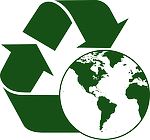
Through electricity, heating, and water consumption our homes use much of the planet’s energy. In fact, the U.S. Energy Department estimates homes and other seemingly benign buildings are actually responsible for consuming 39% of our energy and a similar percentage of greenhouse-gas emissions.
These figures point to a possibly bleak future and are the cause for many green movements currently going on in this country and others. The sustainability movement is creating new ideas about the future of design and energy-efficiency.
So, what will the sustainable homes of the future look like?
A Literal Treehouse
Some futuristic architects have speculated the houses of the future will look and act very much like trees. The top of the house would act as the “leaves” and would quite possibly contain a photosynthetic layer that would capture sunlight. But unlike solar panels of today which are attached to the structure, usually jutting out above the roofline, this futuristic material would be woven into the fabric of the home’s exterior and generate heat and electricity for the home.
Instead of a home with wood or vinyl siding, the futuristic treehouse would have a sort of “bark” that could be made of a very thin insulating film that could clean itself and heal itself so you wouldn’t have to repair and replace structural elements.
Instead of the typical wood or metal frame – these sustainable homes would possibly use resource-efficient carbon tubes that would support the structure.
And let’s not forget every tree has roots, and this home would also have them in the form of a ground-source heat-pump exchange system that would be buried in your yard. These systems will take advantage of the typically constant temperature of the surrounding soil and control your home’s interior climate. In the winter the system would bring in heat, because the ground is warmer than the surrounding air, and in the summer the system would bring in cool air when the ground’s temperature is lower.
Lizard Houses
One of the most important things for a lizard’s survival is its skin, which is why some architects are turning to these creatures and using their anatomy to design sustainable homes of the future. Imagine a home in the future with a “biomorphic” skin that reacts to the weather. It can go dark in the bright sun and insulate the house from heat and go clear on dark days to absorb as much sunlight and heat as possible. The façade of these future homes will also have the ability to capture rain and condensation which will fill the home’s water needs. In this way, the home is like the lizard that lives in the desert that rolls a drop of dew from its nose to its mouth.
The Garden House
Image a three-story home whose exterior walls are covered in vertical gardens that can grow everything from beans, tomatoes, various teas, you name it. A homeowner simply needs to go outside and harvest the meals for the day. But the food is not just food, these gardens will actually provide shade and cooling and absorb heat better than any current material like brick or stucco or wood.
Most likely, rooftop reservoirs will collect water, and rooftop windmills will generate energy.
Although some of these design ideas seem farfetched now (remember how airplanes seemed farfetched at one time?) they will likely take shape in the coming years as more and more people compete for energy resources.
No matter what type of home your children may live in in the future, whether it has leaves or scales, it will still need to have a beautiful interior made from eco-friendly and sustainable material like bamboo. We strongly believe is a valuable green material that will never go out of style.
If you have to resist any questions, please contact us!
Last update of the article: 11/18/2020.

About the Author
James is your friendly neighborhood content writer here at the Green Living Blog. With a passion for all things sustainable, he’s your go-to guru for everything eco-friendly. Armed with a treasure trove of wisdom about sustainable living, recycling, and environmentally conscious practices, James is on a mission. He’s here to make sure you not only protect your family but also keep Mother Earth smiling. 😊🌎 When he’s not busy sharing eco-friendly insights, James can often be found teaching his cat that compost bins make the purr-fect hideaway. 🐱♻️ Join James on his quest to uncover the secrets of defeating wasteful habits while leaving the lightest footprint on our precious planet’s ecosystem.
